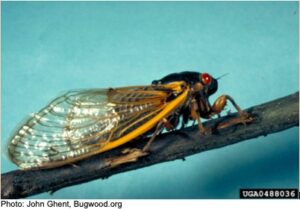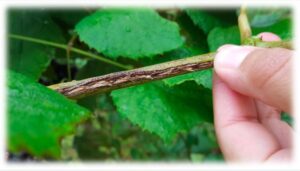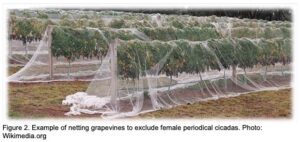The periodical cicada (Figure 1) emergence is expected to begin shortly. Female cicadas lay eggs in 200+ woody tree species (Figure 2), and they have a strong preference for grapevines, apples, cherries, peaches, & plums. Egg laying can weaken and damage branches, causing them to turn brown, die, and break off. The loss of branches could cause serious damage or even death to young trees & grapevines. Cicada nymphs have also been known to feed on roots, which may cause a reduction in vigor.
Figure 1. Periodical cicada. Photo: John Ghent, Bugwood.org
Figure 2. Cutting/slitting egg laying damage caused by female periodical cicadas on grapevines. Photo: E. Y. Long
What can you do?
Young trees with branches and stems ranging in diameter from 3/16″ to 7/16″ are susceptible to cicada damage, and thus should be the main focus of protective efforts. Insect netting can be used to prevent females from accessing grapevines to deposit eggs (Figure 3). Netting should have no larger than 1/2-inch openings and should be fastened around the bottom of the trunk. The best time to do this is when male cicadas begin “singing” and before egg laying begins. Nets should be kept on 2 weeks past when “singing” stops, which is estimated to be around late July.
Chemical control is also an option, but it is only recommended for large, commercial vineyards where netting is not feasible. Chemical control is not as effective as netting because insecticides must be applied repeatedly against waves of cicadas over an ~1 month period whereas netting is only applied once to exclude egg-laying females. Further, chemical control is only recommended for reducing cicada injury to young vines because mature vines can typically tolerate egg laying damage. See link below for more information on chemical control.
Figure 3. Example of netting grapevines to exclude female periodical cicadas. Photo: Wikimedia.org
For more information:
How can I get involved?
Purdue University Cicada Tracker- Citizen Science Project
Please contact Miranda Purcell, Viticulture Extension Specialist, with any questions (mrpurcel@purdue.edu).


